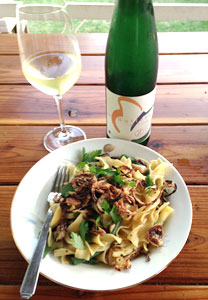| « Previous | News | Next » |
August 11, 2015
Riesling: Laser Beams and Rainbows
 If ever there was a lone wolf of wine grapes, it would be Riesling. It doesn’t take kindly to strangers (you’ll rarely see it blended with other grapes) or invasive oak treatment. It can be sweet as pie or as bracingly nervous as a freshman on the first day of school. It has precision and power, yet delicate, seductive aromatics. It can transmit the characteristics of a vineyard site while still expressing its fundamental Riesling-ness. It’s one of the most flexible, food-friendly wines. Also even high-quality Rieslings generally cost much less—maybe double digits—than, for example, comparable Grand Cru wines from Burgundy (as Stuart Piggott put it in The Best White Wine on Earth: “It’s a special wine we can afford”). It’s unlike any other grape, and it’s no wonder somms routinely wax rhapsodic about it.
If ever there was a lone wolf of wine grapes, it would be Riesling. It doesn’t take kindly to strangers (you’ll rarely see it blended with other grapes) or invasive oak treatment. It can be sweet as pie or as bracingly nervous as a freshman on the first day of school. It has precision and power, yet delicate, seductive aromatics. It can transmit the characteristics of a vineyard site while still expressing its fundamental Riesling-ness. It’s one of the most flexible, food-friendly wines. Also even high-quality Rieslings generally cost much less—maybe double digits—than, for example, comparable Grand Cru wines from Burgundy (as Stuart Piggott put it in The Best White Wine on Earth: “It’s a special wine we can afford”). It’s unlike any other grape, and it’s no wonder somms routinely wax rhapsodic about it.
Riesling currently makes up only about 1 percent of world wine production, but it’s been the fastest growing varietal in the U.S. market for five straight years. The child of the Heunisch (Gouiais Blanc) and Traminer (Savagnin) grapes, Riesling has been around at least since 1435, where we have the earliest documentation in Russelsheim, Germany. It is a late-budding, late-ripening stoic that takes quite a bit longer to develop physiological ripeness than most other grapes, often being harvested into November. Fortunately, it’s well equipped for the cooler climates that allow it the long hang time: its rootstocks are particularly hardy, and its buds are so resistant to frost that winter pruning can begin earlier than with most other varieties.
Its one Achilles heel would be its propensity to botrytis, but this, of course, can be a positive, depending on the style of wine that a winemaker is trying to achieve. Riper, honeyed notes and broader palates are often a result of botrytised grapes. Because of its amazing amount of acidity—both tartaric (ripe) and malic (unripe)—it can balance botrytised grapes into complex, elegant wines that often are right at home on the table. It can be vinified up and down the sweetness spectrum. According to Jancis Robinson in the Oxford Companion to Wine, its high natural level of tartaric acid provides a “more dependable counterbalance to high residual sugar than, for example, the Semillon grape of Sauternes.”
What’s more, Riesling can be made all over the globe. It thrives in cool climates, but has found success even in Australia, which is around the (warm!) 33rd parallel (think Morocco). What happens is that the Riesling grapevine shuts down just before the temperature reaches 90 degrees Fahrenheit, which slows—even stops—the ripening process. It can actually even be hard to ripen the fruit fully in sun-drenched Oz, thanks to this defense mechanism. The result is laserbeam acidity and intense aroma. Its acidity also makes it one of the longest-lived white wines on the planet. Riesling is a survivor.
But don’t take our word for it. We have an international tour de force of Rieslings in various food-friendly styles. This is by no means exhaustive, but will help you get your feet wet—and what a delicious foot baptism it will be!
Alsatian Style: Big is Beautiful
With roots in both France and Germany, Alsace is a wonderland of idiosyncratic wines. This is the only region in France, in fact, where Riesling is officially allowed. Its dry climate minimizes the risk of rot, while simultaneously giving the grape a long hang time to ripen. The style here is bone dry and highly aromatic. It’s often high in alcohol, and decidedly rich in texture and power.
2012 Domaine Barmes Buecher, Herrenweg, Alsace
 Barmes Buecher’s certified biodynamic vines grow on sandy soils around Turckheim, near the renowned Domaine Zind-Humbrecht. According to Antonio Galloni: “It’s a particularly dry site—in fact one of the driest in all of France.” The grapes here achieve bold ripeness and major weight without a hint of botrytis.
Barmes Buecher’s certified biodynamic vines grow on sandy soils around Turckheim, near the renowned Domaine Zind-Humbrecht. According to Antonio Galloni: “It’s a particularly dry site—in fact one of the driest in all of France.” The grapes here achieve bold ripeness and major weight without a hint of botrytis.
In the glass, the wine is a deep poppy yellow, with shimmery gold flakes. It’s quite bright on the nose, showing fresh stone fruit, wet slate, tropical pineapple, white flower. As it opens up, the floral notes become particularly pronounced. It has a voluptuous body, with notes of tropical mango, gardenia, wet slate, a little bit of burnt sugar on the palate. The finish is dry and smooth. Pair with Vietnamese Chicken Wings and Lemongrass Brown Rice.
2009 Davis Family Vineyards Riesling, Santa Lucia Highlands
Also in a more Alsatian style. Grown on the eastern slope of Salinas Valley in Monterey County, this exhibits a sunshiny, golden color and medium body. Notes of petrol appear up front, as will happen when Riesling gains some bottle age. That gives way to honeycrisp apple, a touch of honeycomb, pineapple, and lanolin. It’s a bit tight in the glass at first and needs air. In fact, it’s a bit edgy in general, which suggests that it would do well with a few more years in bottle. It’s substantial on the palate with ricola, mentholy herbal notes. Pair with a stuffed poblano pepper—the balance between sweet golden currants and the poblano’s spice work very well with this wine.
Pfalz Style: Lean, Mean, Fighting Machine The warm, dry climate of the Pfalz (the Haardt Mountains provide a rain shadow for the region) is perfect for making powerful dry Rieslings: the grapes often ripen up to over 12 percent ABV and are particularly suitable for vinification to completely dry. These are sleek and linear—not to mention lip-smackingly good.
2013 Pfeffingen Riesling Trocken, Pfalz
250 years of tradition lay behind this family-run member of the VDP. The wine is a clear lemon-yellow with silver flecks. The aromatics are fierce (in the Tyra Banks way, not the untamed lion way. Well, maybe in that way, too). Right away, you get a beautiful, pristine stoniness on the nose, as fresh as an untouched river, with hints of lemon and golden baked apple. It is silky and elegant on the palate, and streamlined on the laser-sharp finish. Lightweight with a lot of lift, it really captures the experience of biting into a fresh, cold grape.
2013 Corvidae ‘Ravenna’ Riesling, Columbia Valley
The Columbia Valley is home to the U.S.’s largest Riesling industry—20 million bottles per year. It’s a dry, sunny climate, with a cold winter. The Corvidae ‘Ravenna’ shares much in common with the Pfalz style: bone dry, sleek, and crisp, with big aromatics. In the glass, it’s a light greenish-yellow/chartreuse color. Its fragrance is bright lemon, lime, and granny smith apple. Its body is light and lean. The palate has a salty-seaweed note, which, when combined with the tantalizing acidity on the finish, makes you want to return for another sip.
Mosel Style: Semi-Sweet and Light on Its Feet
Grown on steep—nearly vertical—slopes in quaint hamlets above a tightly winding river, this is perhaps the prototypical German winemaking image—and, perhaps the prototypical image of German wine. Mosel Rieslings are incredibly aromatic and elegant; light in weight, but very impactful. Because it is so cool in this region at the 50th parallel, the alcohol in the wines never eclipse the aromatics in the grapes. The sweetness may also serve to accentuate the aromas. These are no shy wallflowers. They may tend to be light in weight, but so was Audrey Hepburn.
2014 Zilliken ‘Butterfly’ Riesling, Mosel
 Stuart Piggott says the name of Ziliken “is often whispered in awe by somms and wine geeks…. Seldom are German Rieslings of the Kabinett class as brilliant as those from the Zilliken family’s from the Rausch vineyard site of Saarburger.” The wine is pale lemon color with hints of grassy green in the glass. Stone and citrus notes intertwine as they waft from the nose, then chords of fresh spring blossoms. It has an ethereal sweetness on the palate, but a diamond-bright acidity on the finish, which is wrapped in notes of springtime. Hanno Zilliken has called this wine “Butterfly” because of “their bright colors and the way they weigh almost nothing even when they’re almost as big as your hand.” (The Best White Wine on Earth) It’ll be Thai food’s best friend, and maybe yours, too.
Stuart Piggott says the name of Ziliken “is often whispered in awe by somms and wine geeks…. Seldom are German Rieslings of the Kabinett class as brilliant as those from the Zilliken family’s from the Rausch vineyard site of Saarburger.” The wine is pale lemon color with hints of grassy green in the glass. Stone and citrus notes intertwine as they waft from the nose, then chords of fresh spring blossoms. It has an ethereal sweetness on the palate, but a diamond-bright acidity on the finish, which is wrapped in notes of springtime. Hanno Zilliken has called this wine “Butterfly” because of “their bright colors and the way they weigh almost nothing even when they’re almost as big as your hand.” (The Best White Wine on Earth) It’ll be Thai food’s best friend, and maybe yours, too.
Written by Kate Soto
